Amazon's Success: A Detailed Case Study on Business Model & History
VerifiedAdded on 2022/08/22
|11
|1623
|22
Case Study
AI Summary
This case study provides an in-depth analysis of Amazon, a multinational e-retailer founded by Jeff Bezos in 1994. Initially an online bookstore, Amazon expanded its offerings to include electronics, apparel, and more, prioritizing customer satisfaction, innovation, and operational excellence. The study traces Amazon's history from its early days in a Bellevue, Washington garage to its IPO in 1997 and subsequent diversification into various product categories and services like Amazon Prime and Kindle. Key aspects of Amazon's business model, including its key partners, cost structure, revenue streams, customer relationships, key resources, key activities, value propositions, channels, and customer segments, are examined. The case study highlights Amazon's customer-centric approach, strategic acquisitions, and the impact of its Prime membership program on its growth and dominance in the e-commerce industry. The document concludes by providing a list of references.

Paraphrase This Document
Need a fresh take? Get an instant paraphrase of this document with our AI Paraphraser
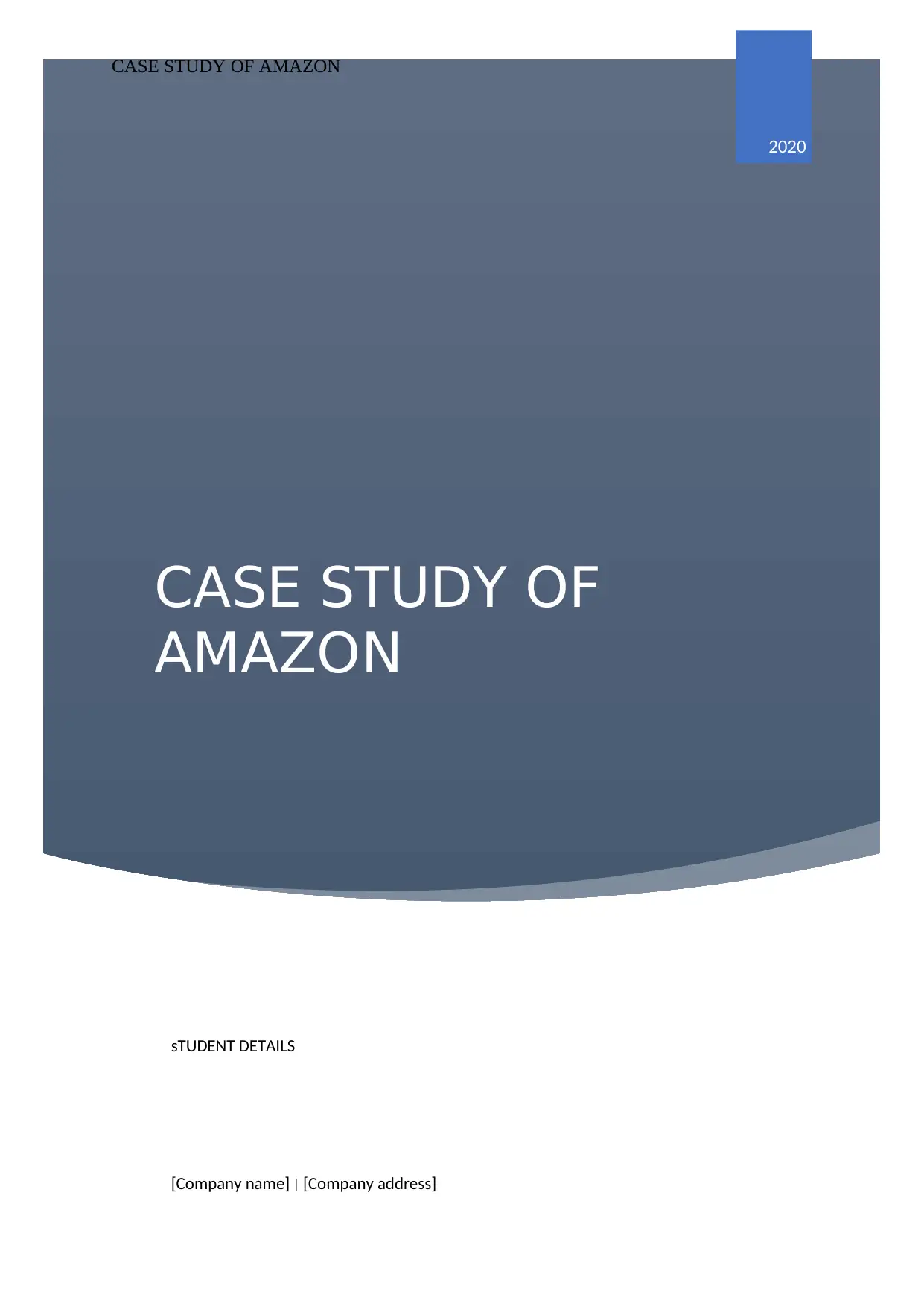
CASE STUDY OF
AMAZON
CASE STUDY OF AMAZON 1 | P a g e
2020
sTUDENT DETAILS
[Company name] | [Company address]
AMAZON
CASE STUDY OF AMAZON 1 | P a g e
2020
sTUDENT DETAILS
[Company name] | [Company address]

CASE STUDY OF AMAZON 2 | P a g e
Table of Contents
1. Company Introduction...........................................................................................................2
2. Brief History of the Organisation...........................................................................................2
3. Business Model of Amazon...................................................................................................6
4. References..............................................................................................................................8
Table of Contents
1. Company Introduction...........................................................................................................2
2. Brief History of the Organisation...........................................................................................2
3. Business Model of Amazon...................................................................................................6
4. References..............................................................................................................................8
⊘ This is a preview!⊘
Do you want full access?
Subscribe today to unlock all pages.

Trusted by 1+ million students worldwide
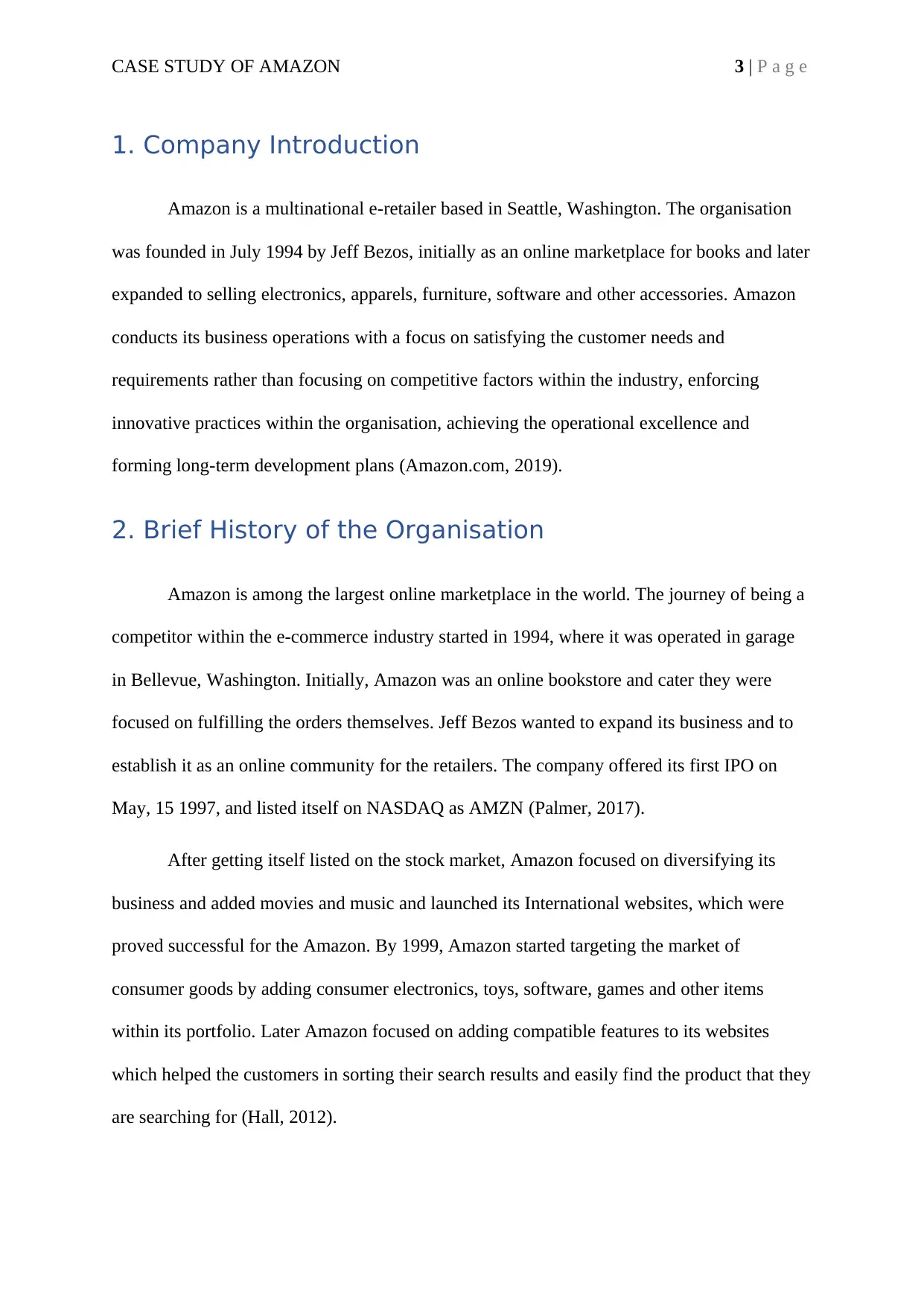
CASE STUDY OF AMAZON 3 | P a g e
1. Company Introduction
Amazon is a multinational e-retailer based in Seattle, Washington. The organisation
was founded in July 1994 by Jeff Bezos, initially as an online marketplace for books and later
expanded to selling electronics, apparels, furniture, software and other accessories. Amazon
conducts its business operations with a focus on satisfying the customer needs and
requirements rather than focusing on competitive factors within the industry, enforcing
innovative practices within the organisation, achieving the operational excellence and
forming long-term development plans (Amazon.com, 2019).
2. Brief History of the Organisation
Amazon is among the largest online marketplace in the world. The journey of being a
competitor within the e-commerce industry started in 1994, where it was operated in garage
in Bellevue, Washington. Initially, Amazon was an online bookstore and cater they were
focused on fulfilling the orders themselves. Jeff Bezos wanted to expand its business and to
establish it as an online community for the retailers. The company offered its first IPO on
May, 15 1997, and listed itself on NASDAQ as AMZN (Palmer, 2017).
After getting itself listed on the stock market, Amazon focused on diversifying its
business and added movies and music and launched its International websites, which were
proved successful for the Amazon. By 1999, Amazon started targeting the market of
consumer goods by adding consumer electronics, toys, software, games and other items
within its portfolio. Later Amazon focused on adding compatible features to its websites
which helped the customers in sorting their search results and easily find the product that they
are searching for (Hall, 2012).
1. Company Introduction
Amazon is a multinational e-retailer based in Seattle, Washington. The organisation
was founded in July 1994 by Jeff Bezos, initially as an online marketplace for books and later
expanded to selling electronics, apparels, furniture, software and other accessories. Amazon
conducts its business operations with a focus on satisfying the customer needs and
requirements rather than focusing on competitive factors within the industry, enforcing
innovative practices within the organisation, achieving the operational excellence and
forming long-term development plans (Amazon.com, 2019).
2. Brief History of the Organisation
Amazon is among the largest online marketplace in the world. The journey of being a
competitor within the e-commerce industry started in 1994, where it was operated in garage
in Bellevue, Washington. Initially, Amazon was an online bookstore and cater they were
focused on fulfilling the orders themselves. Jeff Bezos wanted to expand its business and to
establish it as an online community for the retailers. The company offered its first IPO on
May, 15 1997, and listed itself on NASDAQ as AMZN (Palmer, 2017).
After getting itself listed on the stock market, Amazon focused on diversifying its
business and added movies and music and launched its International websites, which were
proved successful for the Amazon. By 1999, Amazon started targeting the market of
consumer goods by adding consumer electronics, toys, software, games and other items
within its portfolio. Later Amazon focused on adding compatible features to its websites
which helped the customers in sorting their search results and easily find the product that they
are searching for (Hall, 2012).
Paraphrase This Document
Need a fresh take? Get an instant paraphrase of this document with our AI Paraphraser
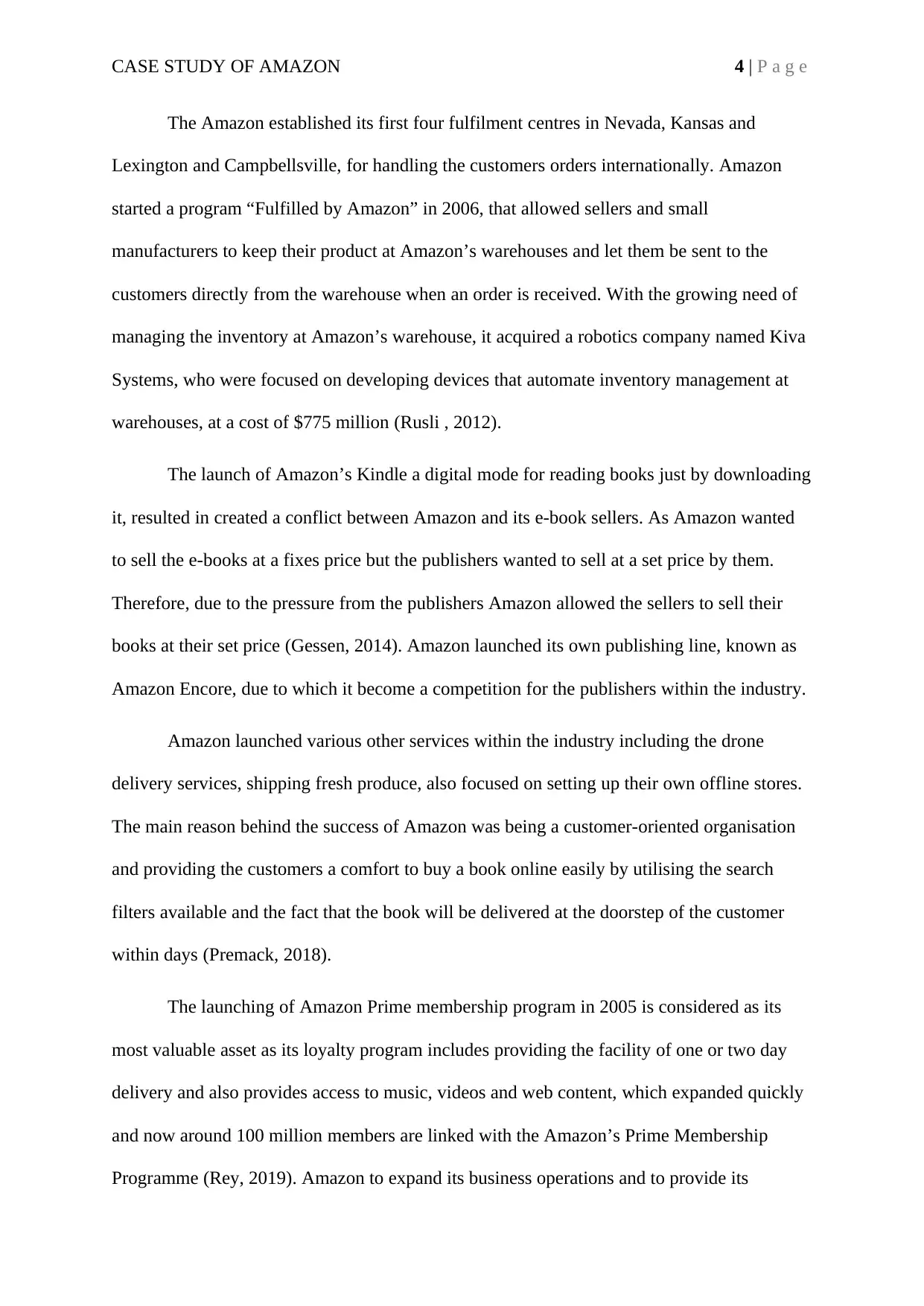
CASE STUDY OF AMAZON 4 | P a g e
The Amazon established its first four fulfilment centres in Nevada, Kansas and
Lexington and Campbellsville, for handling the customers orders internationally. Amazon
started a program “Fulfilled by Amazon” in 2006, that allowed sellers and small
manufacturers to keep their product at Amazon’s warehouses and let them be sent to the
customers directly from the warehouse when an order is received. With the growing need of
managing the inventory at Amazon’s warehouse, it acquired a robotics company named Kiva
Systems, who were focused on developing devices that automate inventory management at
warehouses, at a cost of $775 million (Rusli , 2012).
The launch of Amazon’s Kindle a digital mode for reading books just by downloading
it, resulted in created a conflict between Amazon and its e-book sellers. As Amazon wanted
to sell the e-books at a fixes price but the publishers wanted to sell at a set price by them.
Therefore, due to the pressure from the publishers Amazon allowed the sellers to sell their
books at their set price (Gessen, 2014). Amazon launched its own publishing line, known as
Amazon Encore, due to which it become a competition for the publishers within the industry.
Amazon launched various other services within the industry including the drone
delivery services, shipping fresh produce, also focused on setting up their own offline stores.
The main reason behind the success of Amazon was being a customer-oriented organisation
and providing the customers a comfort to buy a book online easily by utilising the search
filters available and the fact that the book will be delivered at the doorstep of the customer
within days (Premack, 2018).
The launching of Amazon Prime membership program in 2005 is considered as its
most valuable asset as its loyalty program includes providing the facility of one or two day
delivery and also provides access to music, videos and web content, which expanded quickly
and now around 100 million members are linked with the Amazon’s Prime Membership
Programme (Rey, 2019). Amazon to expand its business operations and to provide its
The Amazon established its first four fulfilment centres in Nevada, Kansas and
Lexington and Campbellsville, for handling the customers orders internationally. Amazon
started a program “Fulfilled by Amazon” in 2006, that allowed sellers and small
manufacturers to keep their product at Amazon’s warehouses and let them be sent to the
customers directly from the warehouse when an order is received. With the growing need of
managing the inventory at Amazon’s warehouse, it acquired a robotics company named Kiva
Systems, who were focused on developing devices that automate inventory management at
warehouses, at a cost of $775 million (Rusli , 2012).
The launch of Amazon’s Kindle a digital mode for reading books just by downloading
it, resulted in created a conflict between Amazon and its e-book sellers. As Amazon wanted
to sell the e-books at a fixes price but the publishers wanted to sell at a set price by them.
Therefore, due to the pressure from the publishers Amazon allowed the sellers to sell their
books at their set price (Gessen, 2014). Amazon launched its own publishing line, known as
Amazon Encore, due to which it become a competition for the publishers within the industry.
Amazon launched various other services within the industry including the drone
delivery services, shipping fresh produce, also focused on setting up their own offline stores.
The main reason behind the success of Amazon was being a customer-oriented organisation
and providing the customers a comfort to buy a book online easily by utilising the search
filters available and the fact that the book will be delivered at the doorstep of the customer
within days (Premack, 2018).
The launching of Amazon Prime membership program in 2005 is considered as its
most valuable asset as its loyalty program includes providing the facility of one or two day
delivery and also provides access to music, videos and web content, which expanded quickly
and now around 100 million members are linked with the Amazon’s Prime Membership
Programme (Rey, 2019). Amazon to expand its business operations and to provide its
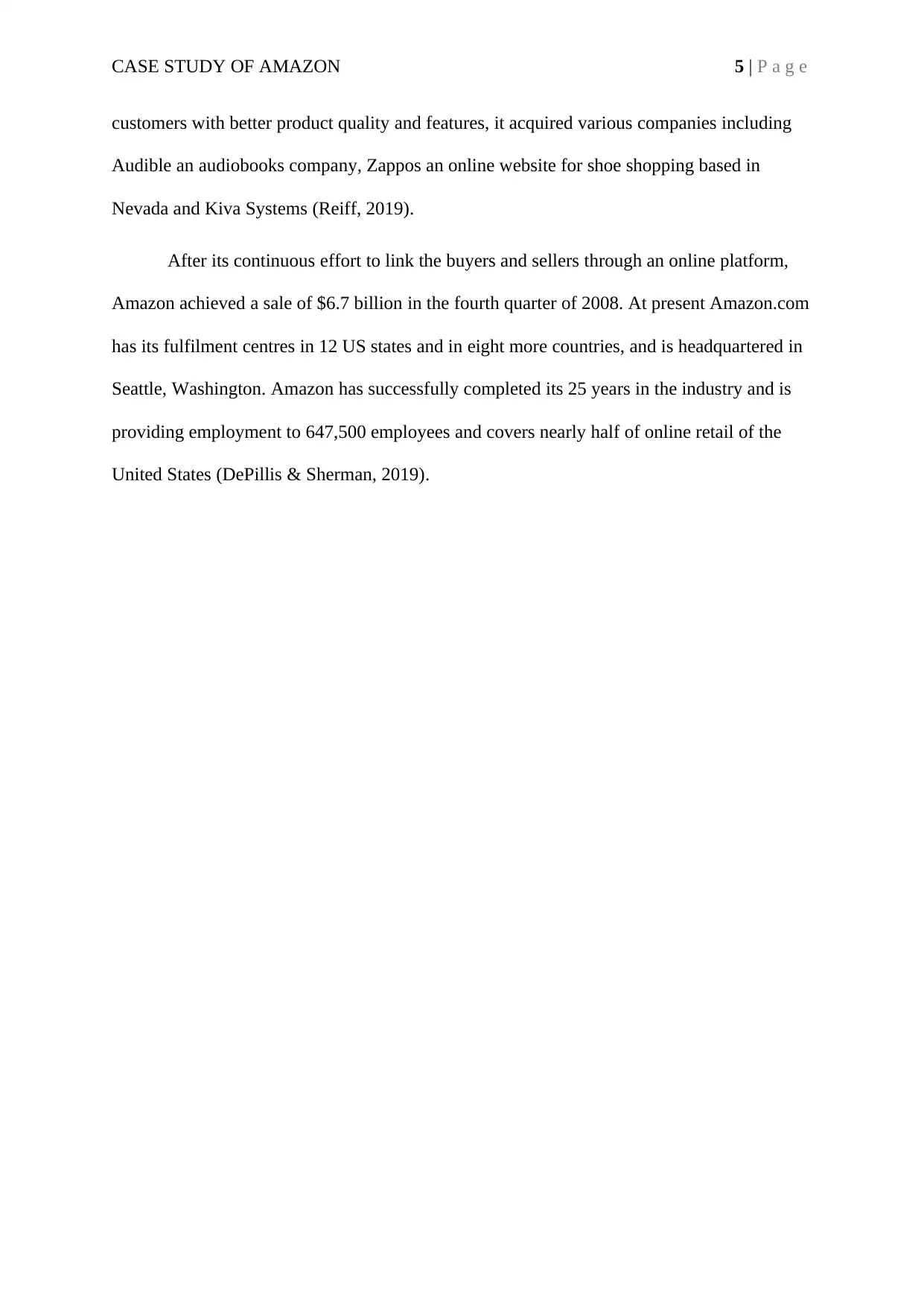
CASE STUDY OF AMAZON 5 | P a g e
customers with better product quality and features, it acquired various companies including
Audible an audiobooks company, Zappos an online website for shoe shopping based in
Nevada and Kiva Systems (Reiff, 2019).
After its continuous effort to link the buyers and sellers through an online platform,
Amazon achieved a sale of $6.7 billion in the fourth quarter of 2008. At present Amazon.com
has its fulfilment centres in 12 US states and in eight more countries, and is headquartered in
Seattle, Washington. Amazon has successfully completed its 25 years in the industry and is
providing employment to 647,500 employees and covers nearly half of online retail of the
United States (DePillis & Sherman, 2019).
customers with better product quality and features, it acquired various companies including
Audible an audiobooks company, Zappos an online website for shoe shopping based in
Nevada and Kiva Systems (Reiff, 2019).
After its continuous effort to link the buyers and sellers through an online platform,
Amazon achieved a sale of $6.7 billion in the fourth quarter of 2008. At present Amazon.com
has its fulfilment centres in 12 US states and in eight more countries, and is headquartered in
Seattle, Washington. Amazon has successfully completed its 25 years in the industry and is
providing employment to 647,500 employees and covers nearly half of online retail of the
United States (DePillis & Sherman, 2019).
⊘ This is a preview!⊘
Do you want full access?
Subscribe today to unlock all pages.

Trusted by 1+ million students worldwide
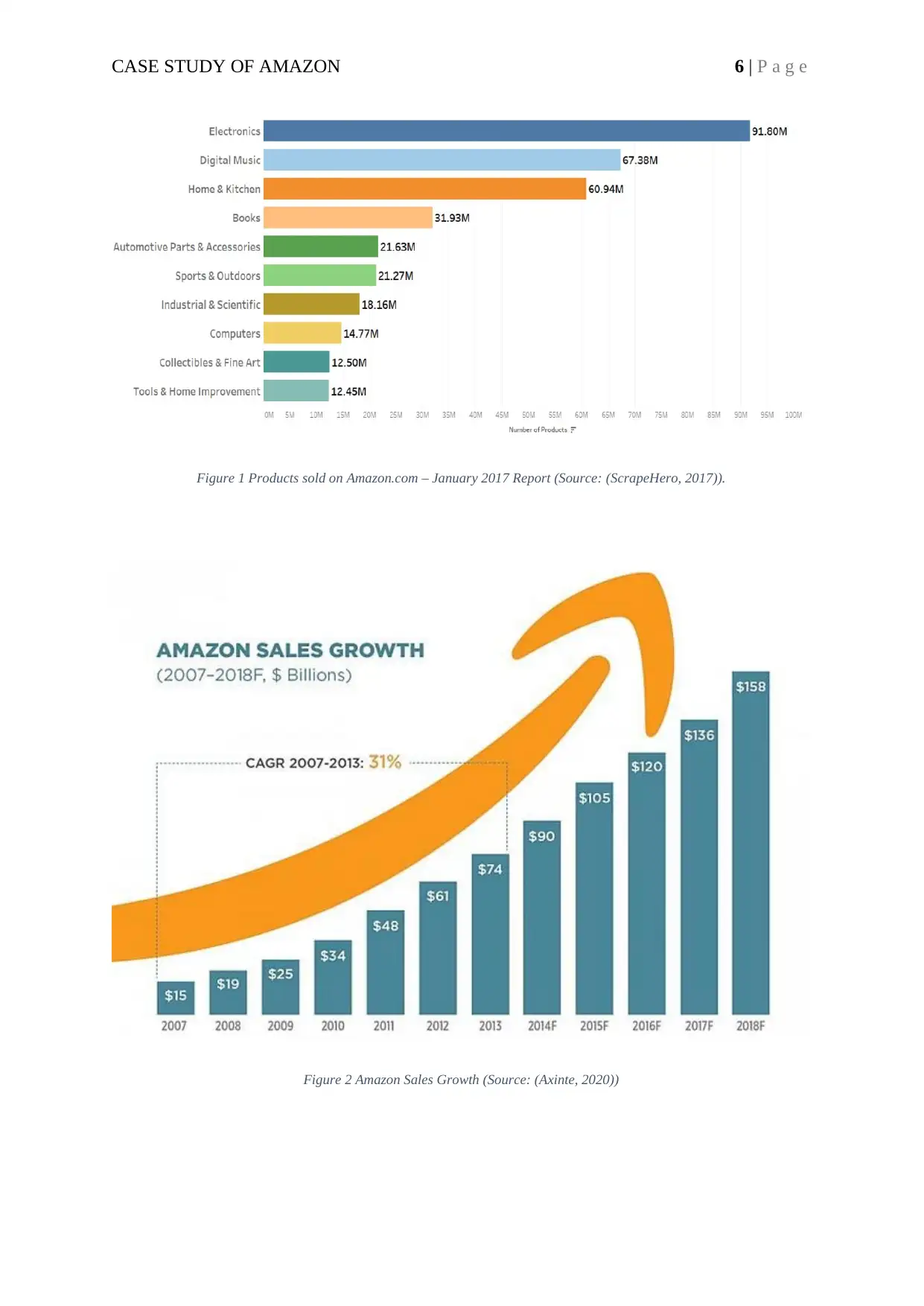
CASE STUDY OF AMAZON 6 | P a g e
Figure 1 Products sold on Amazon.com – January 2017 Report (Source: (ScrapeHero, 2017)).
Figure 2 Amazon Sales Growth (Source: (Axinte, 2020))
Figure 1 Products sold on Amazon.com – January 2017 Report (Source: (ScrapeHero, 2017)).
Figure 2 Amazon Sales Growth (Source: (Axinte, 2020))
Paraphrase This Document
Need a fresh take? Get an instant paraphrase of this document with our AI Paraphraser
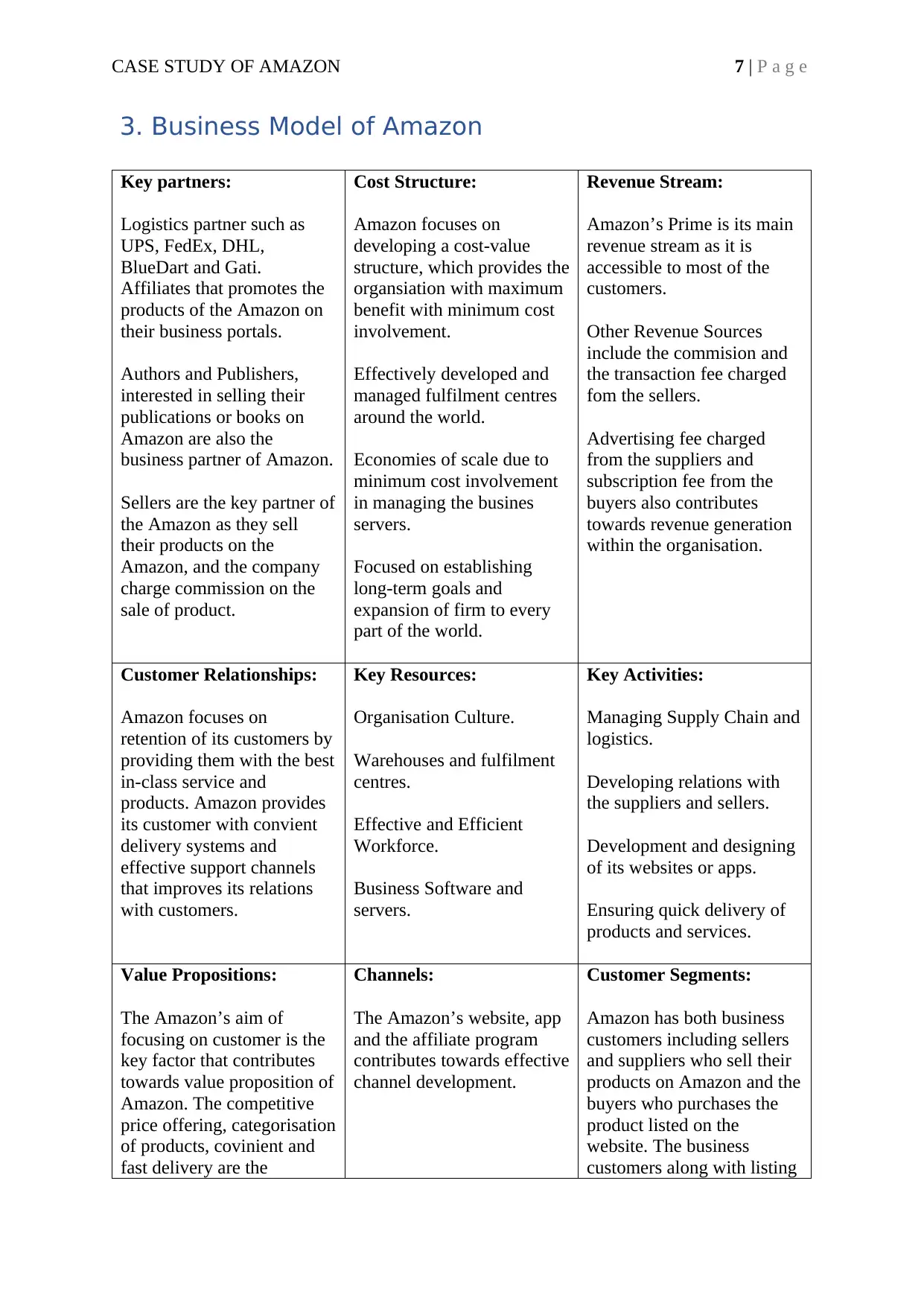
CASE STUDY OF AMAZON 7 | P a g e
3. Business Model of Amazon
Key partners:
Logistics partner such as
UPS, FedEx, DHL,
BlueDart and Gati.
Affiliates that promotes the
products of the Amazon on
their business portals.
Authors and Publishers,
interested in selling their
publications or books on
Amazon are also the
business partner of Amazon.
Sellers are the key partner of
the Amazon as they sell
their products on the
Amazon, and the company
charge commission on the
sale of product.
Cost Structure:
Amazon focuses on
developing a cost-value
structure, which provides the
organsiation with maximum
benefit with minimum cost
involvement.
Effectively developed and
managed fulfilment centres
around the world.
Economies of scale due to
minimum cost involvement
in managing the busines
servers.
Focused on establishing
long-term goals and
expansion of firm to every
part of the world.
Revenue Stream:
Amazon’s Prime is its main
revenue stream as it is
accessible to most of the
customers.
Other Revenue Sources
include the commision and
the transaction fee charged
fom the sellers.
Advertising fee charged
from the suppliers and
subscription fee from the
buyers also contributes
towards revenue generation
within the organisation.
Customer Relationships:
Amazon focuses on
retention of its customers by
providing them with the best
in-class service and
products. Amazon provides
its customer with convient
delivery systems and
effective support channels
that improves its relations
with customers.
Key Resources:
Organisation Culture.
Warehouses and fulfilment
centres.
Effective and Efficient
Workforce.
Business Software and
servers.
Key Activities:
Managing Supply Chain and
logistics.
Developing relations with
the suppliers and sellers.
Development and designing
of its websites or apps.
Ensuring quick delivery of
products and services.
Value Propositions:
The Amazon’s aim of
focusing on customer is the
key factor that contributes
towards value proposition of
Amazon. The competitive
price offering, categorisation
of products, covinient and
fast delivery are the
Channels:
The Amazon’s website, app
and the affiliate program
contributes towards effective
channel development.
Customer Segments:
Amazon has both business
customers including sellers
and suppliers who sell their
products on Amazon and the
buyers who purchases the
product listed on the
website. The business
customers along with listing
3. Business Model of Amazon
Key partners:
Logistics partner such as
UPS, FedEx, DHL,
BlueDart and Gati.
Affiliates that promotes the
products of the Amazon on
their business portals.
Authors and Publishers,
interested in selling their
publications or books on
Amazon are also the
business partner of Amazon.
Sellers are the key partner of
the Amazon as they sell
their products on the
Amazon, and the company
charge commission on the
sale of product.
Cost Structure:
Amazon focuses on
developing a cost-value
structure, which provides the
organsiation with maximum
benefit with minimum cost
involvement.
Effectively developed and
managed fulfilment centres
around the world.
Economies of scale due to
minimum cost involvement
in managing the busines
servers.
Focused on establishing
long-term goals and
expansion of firm to every
part of the world.
Revenue Stream:
Amazon’s Prime is its main
revenue stream as it is
accessible to most of the
customers.
Other Revenue Sources
include the commision and
the transaction fee charged
fom the sellers.
Advertising fee charged
from the suppliers and
subscription fee from the
buyers also contributes
towards revenue generation
within the organisation.
Customer Relationships:
Amazon focuses on
retention of its customers by
providing them with the best
in-class service and
products. Amazon provides
its customer with convient
delivery systems and
effective support channels
that improves its relations
with customers.
Key Resources:
Organisation Culture.
Warehouses and fulfilment
centres.
Effective and Efficient
Workforce.
Business Software and
servers.
Key Activities:
Managing Supply Chain and
logistics.
Developing relations with
the suppliers and sellers.
Development and designing
of its websites or apps.
Ensuring quick delivery of
products and services.
Value Propositions:
The Amazon’s aim of
focusing on customer is the
key factor that contributes
towards value proposition of
Amazon. The competitive
price offering, categorisation
of products, covinient and
fast delivery are the
Channels:
The Amazon’s website, app
and the affiliate program
contributes towards effective
channel development.
Customer Segments:
Amazon has both business
customers including sellers
and suppliers who sell their
products on Amazon and the
buyers who purchases the
product listed on the
website. The business
customers along with listing

CASE STUDY OF AMAZON 8 | P a g e
Amazon’s competitive edge. their products also advertise
on Amazon.
Amazon’s competitive edge. their products also advertise
on Amazon.
⊘ This is a preview!⊘
Do you want full access?
Subscribe today to unlock all pages.

Trusted by 1+ million students worldwide
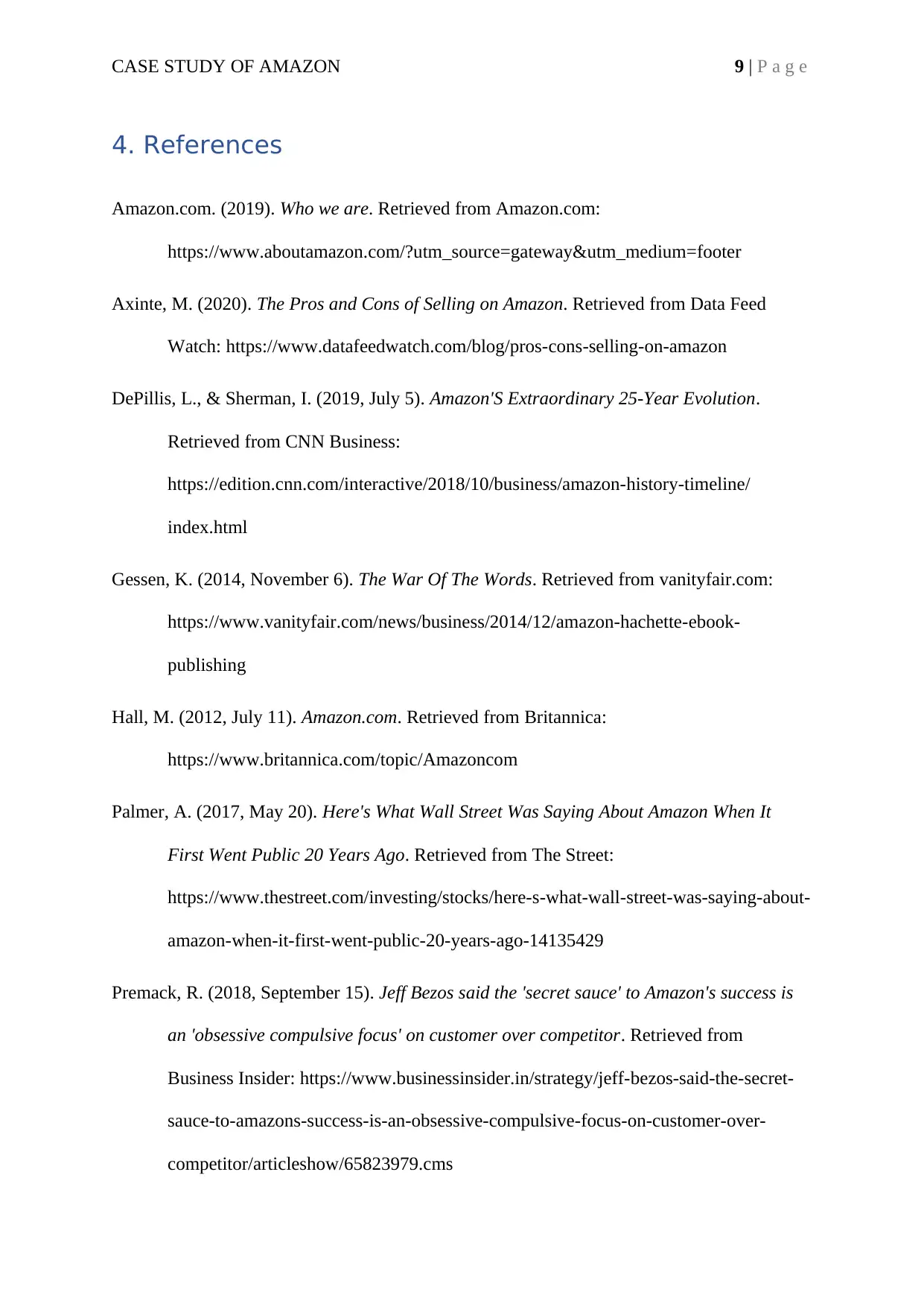
CASE STUDY OF AMAZON 9 | P a g e
4. References
Amazon.com. (2019). Who we are. Retrieved from Amazon.com:
https://www.aboutamazon.com/?utm_source=gateway&utm_medium=footer
Axinte, M. (2020). The Pros and Cons of Selling on Amazon. Retrieved from Data Feed
Watch: https://www.datafeedwatch.com/blog/pros-cons-selling-on-amazon
DePillis, L., & Sherman, I. (2019, July 5). Amazon'S Extraordinary 25-Year Evolution.
Retrieved from CNN Business:
https://edition.cnn.com/interactive/2018/10/business/amazon-history-timeline/
index.html
Gessen, K. (2014, November 6). The War Of The Words. Retrieved from vanityfair.com:
https://www.vanityfair.com/news/business/2014/12/amazon-hachette-ebook-
publishing
Hall, M. (2012, July 11). Amazon.com. Retrieved from Britannica:
https://www.britannica.com/topic/Amazoncom
Palmer, A. (2017, May 20). Here's What Wall Street Was Saying About Amazon When It
First Went Public 20 Years Ago. Retrieved from The Street:
https://www.thestreet.com/investing/stocks/here-s-what-wall-street-was-saying-about-
amazon-when-it-first-went-public-20-years-ago-14135429
Premack, R. (2018, September 15). Jeff Bezos said the 'secret sauce' to Amazon's success is
an 'obsessive compulsive focus' on customer over competitor. Retrieved from
Business Insider: https://www.businessinsider.in/strategy/jeff-bezos-said-the-secret-
sauce-to-amazons-success-is-an-obsessive-compulsive-focus-on-customer-over-
competitor/articleshow/65823979.cms
4. References
Amazon.com. (2019). Who we are. Retrieved from Amazon.com:
https://www.aboutamazon.com/?utm_source=gateway&utm_medium=footer
Axinte, M. (2020). The Pros and Cons of Selling on Amazon. Retrieved from Data Feed
Watch: https://www.datafeedwatch.com/blog/pros-cons-selling-on-amazon
DePillis, L., & Sherman, I. (2019, July 5). Amazon'S Extraordinary 25-Year Evolution.
Retrieved from CNN Business:
https://edition.cnn.com/interactive/2018/10/business/amazon-history-timeline/
index.html
Gessen, K. (2014, November 6). The War Of The Words. Retrieved from vanityfair.com:
https://www.vanityfair.com/news/business/2014/12/amazon-hachette-ebook-
publishing
Hall, M. (2012, July 11). Amazon.com. Retrieved from Britannica:
https://www.britannica.com/topic/Amazoncom
Palmer, A. (2017, May 20). Here's What Wall Street Was Saying About Amazon When It
First Went Public 20 Years Ago. Retrieved from The Street:
https://www.thestreet.com/investing/stocks/here-s-what-wall-street-was-saying-about-
amazon-when-it-first-went-public-20-years-ago-14135429
Premack, R. (2018, September 15). Jeff Bezos said the 'secret sauce' to Amazon's success is
an 'obsessive compulsive focus' on customer over competitor. Retrieved from
Business Insider: https://www.businessinsider.in/strategy/jeff-bezos-said-the-secret-
sauce-to-amazons-success-is-an-obsessive-compulsive-focus-on-customer-over-
competitor/articleshow/65823979.cms
Paraphrase This Document
Need a fresh take? Get an instant paraphrase of this document with our AI Paraphraser
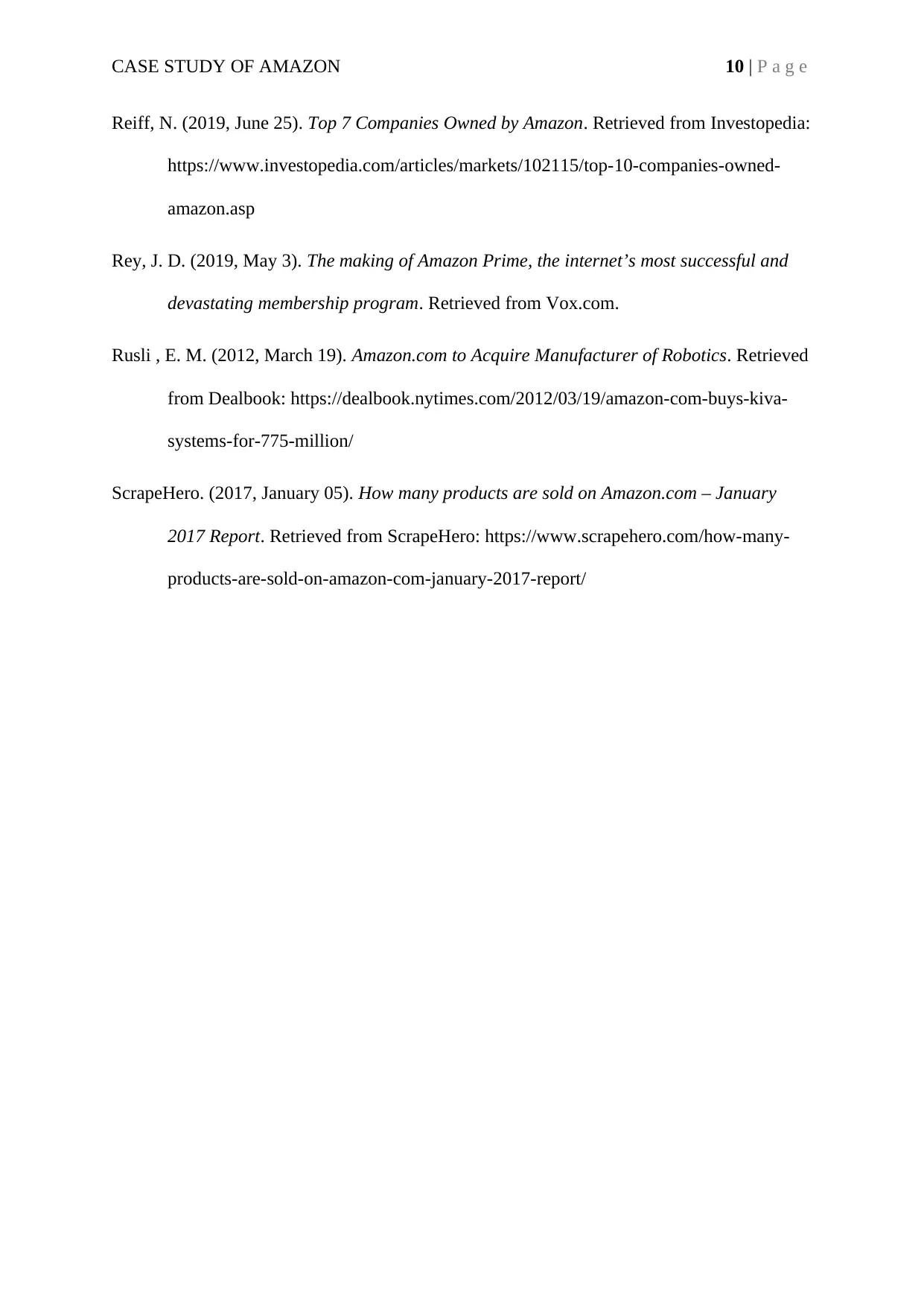
CASE STUDY OF AMAZON 10 | P a g e
Reiff, N. (2019, June 25). Top 7 Companies Owned by Amazon. Retrieved from Investopedia:
https://www.investopedia.com/articles/markets/102115/top-10-companies-owned-
amazon.asp
Rey, J. D. (2019, May 3). The making of Amazon Prime, the internet’s most successful and
devastating membership program. Retrieved from Vox.com.
Rusli , E. M. (2012, March 19). Amazon.com to Acquire Manufacturer of Robotics. Retrieved
from Dealbook: https://dealbook.nytimes.com/2012/03/19/amazon-com-buys-kiva-
systems-for-775-million/
ScrapeHero. (2017, January 05). How many products are sold on Amazon.com – January
2017 Report. Retrieved from ScrapeHero: https://www.scrapehero.com/how-many-
products-are-sold-on-amazon-com-january-2017-report/
Reiff, N. (2019, June 25). Top 7 Companies Owned by Amazon. Retrieved from Investopedia:
https://www.investopedia.com/articles/markets/102115/top-10-companies-owned-
amazon.asp
Rey, J. D. (2019, May 3). The making of Amazon Prime, the internet’s most successful and
devastating membership program. Retrieved from Vox.com.
Rusli , E. M. (2012, March 19). Amazon.com to Acquire Manufacturer of Robotics. Retrieved
from Dealbook: https://dealbook.nytimes.com/2012/03/19/amazon-com-buys-kiva-
systems-for-775-million/
ScrapeHero. (2017, January 05). How many products are sold on Amazon.com – January
2017 Report. Retrieved from ScrapeHero: https://www.scrapehero.com/how-many-
products-are-sold-on-amazon-com-january-2017-report/
1 out of 11
Related Documents
Your All-in-One AI-Powered Toolkit for Academic Success.
+13062052269
info@desklib.com
Available 24*7 on WhatsApp / Email
![[object Object]](/_next/static/media/star-bottom.7253800d.svg)
Unlock your academic potential
Copyright © 2020–2025 A2Z Services. All Rights Reserved. Developed and managed by ZUCOL.


